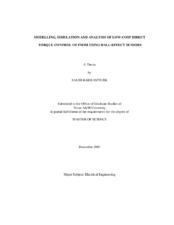| dc.contributor.advisor | Toliyat, Hamid A. | |
| dc.creator | Ozturk, Salih Baris | |
| dc.date.accessioned | 2007-04-25T20:12:20Z | |
| dc.date.available | 2007-04-25T20:12:20Z | |
| dc.date.created | 2005-12 | |
| dc.date.issued | 2007-04-25 | |
| dc.identifier.uri | https://hdl.handle.net/1969.1/4905 | |
| dc.description.abstract | This thesis focuses on the development of a novel Direct Torque Control (DTC) scheme for permanent magnet (PM) synchronous motors (surface and interior types) in the constant torque region with the help of cost-effective hall-effect sensors. This method requires no DC-link sensing, which is a mandatory matter in the conventional DTC drives, therefore it reduces the cost of a conventional DTC of a permanent magnet (PM) synchronous motor and also removes common problems including; resistance change effect, low speed and integration drift. Conventional DTC drives require at least one DC-link voltage sensor (or two on the motor terminals) and two current sensors because of the necessary estimation of position, speed, torque, and stator flux in the stationary reference frame. Unlike the conventional DTC drive, the proposed method uses the rotor reference frame because the rotor position is provided by the three hall-effect sensors and does not require expensive voltage sensors. Moreover, the proposed algorithm takes the acceleration and deceleration of the motor and torque disturbances into account to improve the speed and torque responses. The basic theory of operation for the proposed topology is presented. A mathematical model for the proposed DTC of the PMSM topology is developed. A simulation program written in MATLAB/SIMULINK® is used to verify the basic operation (performance) of the proposed topology. The mathematical model is capable of simulating the steady-state, as well as dynamic response even under heavy load conditions (e.g. transient load torque at ramp up). It is believed that the proposed system offers a reliable and low-cost solution for the emerging market of DTC for PMSM drives. Finally the proposed drive, considering the constant torque region operation, is applied to the agitation part of a laundry washing machine (operating in constant torque region) for speed performance comparison with the current low-cost agitation cycle speed control technique used by washing machine companies around the world. | en |
| dc.format.extent | 4487627 bytes | en |
| dc.format.medium | electronic | en |
| dc.format.mimetype | application/pdf | |
| dc.language.iso | en_US | |
| dc.publisher | Texas A&M University | |
| dc.subject | Direct Torque Control | en |
| dc.subject | Hall-Effect Sensor | en |
| dc.subject | PMSM | en |
| dc.subject | Permanent Magnet Synchronous Motor | en |
| dc.subject | Laundry Washing Machine | en |
| dc.subject | Agitation Cycle Speed Control | en |
| dc.title | Modelling, simulation and analysis of low-cost direct torque control of PMSM using hall-effect sensors | en |
| dc.type | Book | en |
| dc.type | Thesis | en |
| thesis.degree.department | Electrical and Computer Engineering | en |
| thesis.degree.discipline | Electrical Engineering | en |
| thesis.degree.grantor | Texas A&M University | en |
| thesis.degree.name | Master of Science | en |
| thesis.degree.level | Masters | en |
| dc.contributor.committeeMember | Bhattacharyya, S. P. | |
| dc.contributor.committeeMember | Enjeti, Prasad N. | |
| dc.contributor.committeeMember | Langari, Reza | |
| dc.type.genre | Electronic Thesis | en |
| dc.type.material | text | en |
| dc.format.digitalOrigin | born digital | en |


